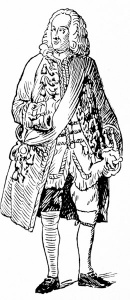
George II (1727-60) continued the Hanoverian rule. Early in his reign (1736) John Wesley began preaching in England. The subsequent Wesleyan societies and later Methodist churches acted as a conservative deterrent to the tide of social unrest and political radicalism that swept much of Europe during the 18th century.
The Bonnie Prince
In 1745, the Young Pretender, Charles Stuart (Bonnie Prince Charlie) landed in Scotland. There he built support, and bolstered by early successes, marched into England.
Instead of the popular uprising he had counted on, he met apathy. Although he reached as far south as Derby, indecisive leadership and lack of popular support meant that Charles had little option but to retreat into Scotland. There he was eventually brought to bay at Culloden Moor, near Inverness, where the Stuart cause finally ended in slaughter. Charles himself escaped to the Isle of Skye and eventually to France, where he ended his life a pathetic drunkard.
It has been said that "Life in early Georgian England was stable, placid, and self-satisfied". This accounts in part for the failure of the Stuarts to raise support for the '15 and '45 rebellions. Despite the Stuart rebellion, the years between 1720-1780 were remarkable for their social stability. This stability was founded upon a system that depended upon the exercise of influence and put the interests of landowners first.
The British Museum
On a happier note, 1753 saw the founding of the British Museum. To the private collections of Sir Hans Sloane and Sir Robert Cotton were added the library of the earls of Oxford and the old Royal library founded by Henry VII. The museum was originally stored in Montagu House, purchased with the proceeds of a public lottery. By the mid 19th century the collection had outgrown Montagu House, so it was torn down and the present building erected under the supervision of Sir Robert Smirke.
The Seven Year's War
England then embarked upon the Seven Years War with France (1755-63). England was victorious just about everywhere, gaining territory in Canada, Florida, Grenada, Senegal, and in America east of the Mississippi.
Success in India
Overseas, the East India Company had established trading posts at Calcutta and Madras. From there they fought with the French for trade supremacy in India. Under Robert Clive ("Clive of India"), the English defeated a combined Indian and French force at Plassey in 1757, and the subcontinent was open to a monopoly by the East India Company.
MORE Georgian Britain:
Back: George I
Next: George III

